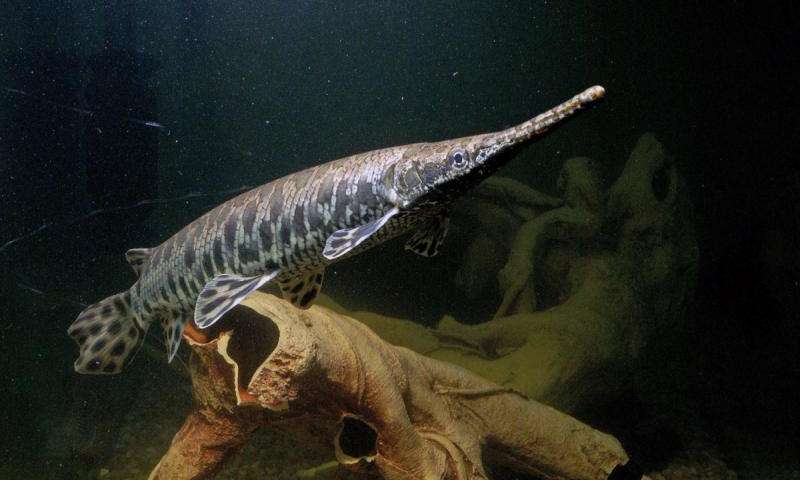Finding our genomic inner fish with the spotted gar

With an elongated snout full of razor sharp teeth and thick, armored scales, the spotted gar isn't a favorite to win any fish beauty pageants. But appearance isn't everything. And it definitely isn't a requirement to make invaluable contributions to science.
Reporting in Nature Genetics on March 7, an international team of scientists, including Neil Shubin, PhD, Robert R. Bensley Professor of Organismal Biology and Anatomy, and members of his lab, have now sequenced the first spotted gar genome. Their findings reveal a unique genetic architecture that more closely resembles tetrapods (four-legged animals) than it does other fish."The gar allows us to find our genomic inner fish," Shubin said. "Because its genome is unduplicated, it enables direct comparisons between fish and mice and people."ScienceLife spoke with Andrew Gehrke, graduate student in organismal biology and anatomy at the University of Chicago and an author on the study, about what the spotted gar can teach us about our own biology.
ScienceLife: Why sequence the spotted gar genome?
Andrew Gehrke: Almost every fish you can think of belongs to a group called the teleosts. Scientists use teleosts, particularly zebrafish, as a model organism to study everything from developmental biology to human diseases such as cancer. They're an incredibly valuable tool for biomedical research. The problem is, teleost genomes are a huge mess. At some point in their evolutionary past, their lineage underwent a massive genome duplication and expansion. For any gene you have one copy of, they might have two or more, for example. As a result, their genomes are big, complicated and shuffled around a lot.

Gar are one of a few species of fish that are not teleosts. They're members of an ancient order of fish that diverged from teleosts around 300 million years ago. They never underwent that big genome expansion and reshuffling, so their genome actually better matches the genomes of tetrapods, including humans. With the gar genome now sequenced, we have a stepping stone that allows us to make much better connections between teleosts and tetrapods, and discover things that we couldn't before.
Could you give us an example?
Of course! The Shubin lab got involved in this study because we study limb development and how the evolutionary transition from fins to limbs occurred. We were interested in regulatory elements known as enhancers, which are genetic switches that turn certain genes on or off. In particular, we were looking for enhancers that regulate genes involved in limb development. Without them, limb formation can't occur. When I first started on this project, I was incredibly frustrated because I couldn't find these switches in any fish. I tried zebrafish, pufferfish, etc., but I never identified any because of how messy the teleost genome is. It was only when our collaborators came to us with the gar genome that the whole box was unlocked. We found all these different enhancers that we couldn't have found before. If we never collaborated, I'd be still banging my head on the wall trying to find these elements. But we did, and it's already been critical for studies that we've published, such as the genetic relationship between fins and fingers. It's hard to overemphasize how important gar was to my work.
What does knowledge of these elements tell us?AG:
Broadly, they tell us that the genetic networks and switches so important for limb development were present in fish, and have been for a very long time. Fish and tetrapods share an ancient, deeply conserved network for making their appendages. The genetic programs used to make fins are similar to those used to make limbs. By studying gar, we identified those shared genetic switches and now know that they were present in the common ancestor of both fish and tetrapods. If we never found them, we would have said that fish and tetrapods evolved very different systems for appendage formation. The gar genome was critical in illuminating our common ancestry.
Is it really necessary to study all these different animal species?
It's incredibly important to study the genomes of lots of different species. Concentrating on one species, on one genome, cannot teach us everything we want or need to understand about biology. We have to study comparatively. Our work on limb enhancers, for example, would never have been possible if we had just studied zebrafish. As soon as we looked broader, a whole new facet of biology was revealed. It also raises many more questions. It's interesting that limb development programs have this deep level of evolutionary conservation, but it looks like they were already present when teleosts and gar diverged. To understand how fins originated, we need to sequence and compare more species-fish that are mostly finless, for example, such as lamprey. Filling out this evolutionary tree is the only way to make meaningful comparisons and fully understand how fins transitioned into limbs.
Does gar now replace zebrafish as a model organism?
Gar can't replace zebrafish, which are such a great system to better understand so many aspects of biology. The gar genome is useful as a bridge between zebrafish and humans. It's hard to directly compare zebrafish and human because of how different our genomes are. Gar now serve as a stepping stone. We can use gar to identify genetic sequences, such as limb enhancers, that we couldn't identify before. This allows us to study them in zebrafish and compare to humans and other species. We can continue to use zebrafish as a great system to understand biology and disease, and it's really enhanced by the gar genome. It might not be the prettiest fish, but the spotted gar genome is now an invaluable scientific tool.
